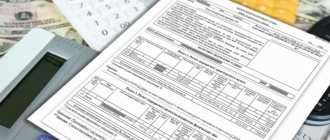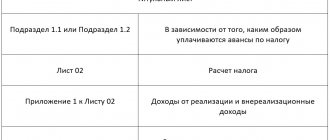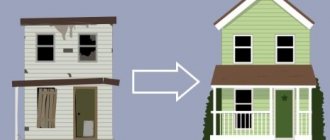Depreciation means transferring the cost of fixed assets (FP) and intangible assets (IA) to the cost of work, services, as well as products manufactured by the enterprise as they wear out. To understand clearly what this is, let’s turn to economic terminology and start with the OS.
OS - means of labor (material assets) involved in the production process. These are, for example, buildings, transport, overpasses, tools, equipment.
Take our proprietary course on choosing stocks on the stock market → training course
Important! OS (structures, tools, etc.) retain their natural shape, are used in the main activity, and have a service life of more than a year.
Various operating systems, for example, tools or the same equipment, participate in a number of production cycles. For the most part, they retain their natural shape for a long time. Gradually, OSs lose their consumer properties, cost and require repair, or even replacement. Taking this into account, the cost of tools, equipment, their repair or replacement is transferred equally to the cost of production. Here we are talking only about the products in the production of which these operating systems are involved, and their standard service life. This transfer is the depreciation of the OS.
What is the purpose of accelerated depreciation?
For certain reasons and under specific conditions, fixed assets are depreciated at an accelerated pace. Then special depreciation rates are applied, and the cost of the operating system is transferred to the final product faster than usual. That is, their formal wear seems to be accelerating.
Thus, the main goal of the process is to accelerate the equal distribution of the value of tangible assets. All increased accruals go to compensate for costs during the service life. This stimulates investment and has a positive effect on the distribution of modernization expenses and the pace of enterprise development.
When accelerated depreciation becomes beneficial to a company
The main obvious advantages of acceleration are as follows:
- quick write-off of OS;
- thanks to the use of special coefficients, a reduction in the tax base and, accordingly, a reduction in the amount of taxes payable;
- tangible replenishment (compensation) of one’s own expenses;
- use of acceleration in leasing, which reduces costs.
Important! The use of accelerated depreciation and the corresponding coefficients must be economically justified and not run counter to the norms of Art. 252 of the Tax Code of the Russian Federation.
Restrictions on the use of the coefficient
The same operating system may meet several criteria, which imply the use of a number of increased (or, as they are often called, accelerated) coefficients. As stated in paragraph 5 of Art. 259.3 of the Tax Code of the Russian Federation , out of the total number of permissible coefficients, only one of them is allowed to be used.
Important! The taxpayer is obliged to record in the accounting policy which acceleration factor from among the possible ones it will apply.
Methods for calculating depreciation
Russian accounting standards today are represented by PBU 6/01. This provision identifies four commonly used methods for calculating depreciation (Am):
- Linear. Am is accrued equally throughout the service life, starting from the initial cost (HC) and ending with the residual value. Current residual article = NS - SNA, where SNA is the total accumulated depreciation of fixed assets.
- Reducing balance (or accelerated). Am for the period = residual value * corresponding %. Am is accrued on the balance at the beginning of the year.
- Write-off of items based on the sum of numbers of years of useful life (hereinafter abbreviated as SPI).
- Write-off is proportional to the volume of products (work). Accrual is based on a specific natural indicator.
Am is accrued in one of the named ways for a group of identical fixed assets, and during the entire SPI of objects of this group.
Methods for calculating depreciation in accounting
An enterprise has the right to use any accrual method that suits it. Usually, when choosing, they start from the ratio of profits and expenses. When choosing the optimal accrual option, most enterprises advocate reducing the difference between the accounting and tax accounting components and bringing them closer together. Therefore, when depreciating fixed assets, preference is given mostly to the linear method. It is suitable when profits flow evenly during the SPI period.
Methods for calculating depreciation in tax accounting
The amount of depreciation that is calculated for taxes is determined independently by the payer each month. The methods and procedure for calculation are established by Art. 259 of the Tax Code of the Russian Federation. Accrual is made:
- Nonlinear method - by depreciation group (subgroup).
- Linear method - according to the object.
The payer can choose any of them and record it in the accounting policy.
Important! You can change the selected accrual method once every 5 years and only with the beginning of a new tax period.
The linear method should always be applied to those operating systems that are listed in paragraph 3 of Art. 259 of the Tax Code of the Russian Federation. Moreover, regardless of which method the payer has chosen and enshrined in its policy.
Separate accounting
If an organization (institution) calculates depreciation using a non-linear method, then fixed assets to which increasing (decreasing) coefficients are applied must be included in separate depreciation subgroups (clause 13 of Article 258 of the Tax Code of the Russian Federation). The fact is that with the non-linear method, depreciation is accrued not for each fixed asset, but for depreciation groups as a whole. Since increasing (decreasing) factors may not apply to all fixed assets included in the depreciation group, they must be taken into account separately. This is stated in paragraph 2 of subparagraph 1 of paragraph 1 of Article 259.3 of the Tax Code of the Russian Federation.
Under what conditions is it permissible to use accelerated depreciation (list of situations)
Important! Accelerated depreciation is applied only to a limited range of assets that are characterized by rapid wear and tear. Their list is determined by Art. 259.3 Tax Code of the Russian Federation .
For all operating systems from the list, the so-called acceleration coefficient is applied (K = up to 2 or K = up to 3). Details of the OS list are given below along with the odds sizes.
Increasing coefficients for fixed assets used in aggressive environments
An aggressive environment is understood as an environment that can negatively affect surrounding materials and structures and cause their destruction. Under its influence, the wear and tear of the OS accelerates. A striking example is the interaction of an OS with a toxic substance.
Under these circumstances, it is permissible to use K = no more than 2. This norm does not apply when using a non-linear technique in relation to objects 1, 2 and 3 of depreciation. gr.
In fact, acceleration can also be used when depreciating objects that, according to their intended purpose, should not be used in an aggressive environment. If the documentation contains a note about the possibility of such use, then it is usually used when there is an excess of the standards stated in the documents.
Important! The use of an increased coefficient applies only to those objects that are exposed to an aggressive environment. The remaining fixed assets are subject to depreciation in the usual manner, without acceleration.
Depreciation of fixed assets used in scientific and technical activities
All objects participating in this activity are subject to accelerated depreciation with the participation of K = up to 3. The concept of “scientific and technical activity” (hereinafter abbreviated as NTD) is explained by Art. 2 Federal Law of the Russian Federation No. 127 dated August 23, 1996. Nevertheless, the Ministry of Finance of the Russian Federation, referring to the norms of Art. 262 of the Tax Code of the Russian Federation, also includes research and design developments.
Accelerated depreciation of leased objects (+example)
In the case of leasing, the established coefficient cannot exceed 3. For example, Tekhnika LLC, under a leasing agreement, received equipment classified as 4 depreciation. gr. The validity period of the contract is 3 years. The balance holder (tenant) determined the SPI = 6 years. By agreement of the parties, a coefficient of 2 was established. It is assumed that the equipment will be written off within 3 years of leasing.
Features of accelerated depreciation during leasing:
- When the lessee changes, the lessor continues to charge depreciation.
- If the entire enterprise is comprehensively recognized as a leasing object, then depreciation is charged on all fixed assets. The exceptions are those OS that relate to 1, 2 or 3 depreciations. group.
For your information, the new lessee has the right to change the amount of increase for the property that was transferred to him from the previous lessee.
Using reduction factors
In relation to fixed assets, taxpayers can apply special increasing and decreasing coefficients provided for by the Tax Code of the Russian Federation to the basic depreciation rate.
In accordance with paragraph 7 of Art. 259 of the Tax Code of the Russian Federation, increasing coefficients are provided in relation to:
- depreciable fixed assets used to work in aggressive environments and (or) extended shifts. In this case, the taxpayer has the right to apply a special coefficient, but not higher than 2. An aggressive environment is understood as a set of natural and (or) artificial factors, the influence of which causes increased wear (aging) of fixed assets during their operation. Also, working in an aggressive environment is considered to be the presence of fixed assets in contact with an explosive, fire-hazardous, toxic or other aggressive technological environment, which can serve as the cause (source) of initiating an emergency;
- depreciable fixed assets that are the subject of a financial lease agreement (leasing agreement). In this case, the taxpayer, whose fixed asset must be accounted for in accordance with the terms of the financial lease agreement (leasing agreement), has the right to apply a special coefficient to the basic depreciation rate, but not higher than 3. These provisions do not apply to fixed assets related to the first, the second and third depreciation groups, if depreciation for these fixed assets is calculated using a non-linear method. Taxpayers who transferred (received) fixed assets that are the subject of a leasing agreement concluded before January 1, 2002, have the right to charge depreciation on this property using the methods and norms that existed at the time of transfer (receipt) of the property, as well as using a special coefficient no higher than 3.
https://www.youtube.com/watch{q}v=ytpressru
“Taxpayer organizations that have the status of resident of an industrial-production special economic zone have the right to apply a special coefficient to the basic depreciation rate in relation to their own fixed assets, but not higher than 2.”
Example 5. In February, the organization put into operation a fixed asset item purchased in the same month for 236,000 rubles, including VAT of 36,000 rubles. This fixed asset belongs to the fourth depreciation group, and the organization, when accepting the object for accounting, established a useful life of 6 years (72 months).
The monthly depreciation rate for this fixed asset, calculated based on the established useful life of the object and a special increasing factor, will be 1.94% ((1 / 72 months) x 100% x 1.4).
The amount of monthly depreciation deductions taken into account when taxing profits will be equal to 3880 rubles. (RUB 200,000 x 1.94%).
Calculation of depreciation at rates lower than those established by Art. 259 of the Tax Code of the Russian Federation is permitted by decision of the head of the taxpayer organization. The decision on whether the organization will apply reduction factors when calculating depreciation rates must be enshrined in the organization's accounting policies.
The use of reduced depreciation rates is allowed only from the beginning of the tax period and throughout the entire tax period.
According to paragraph 9 of Art. 259 of the Tax Code of the Russian Federation for passenger cars and passenger minibuses, the initial cost of which, respectively, is more than 300 thousand rubles. and 400 thousand rubles, the basic depreciation rate is applied with a special coefficient of 0.5. It should be noted that the use of a reduction factor for these fixed assets is mandatory and does not depend on the wishes of the organization.
Example 6. In January 2006, an organization put into operation a passenger minibus, the initial cost of which is 470,000 rubles. (without VAT). The minibus, in accordance with Resolution No. 1, belongs to the third depreciation group; the organization, when accepting the object for accounting, established a useful life of 3.5 years (42 months). Depreciation for profit tax purposes is calculated using the straight-line method.
The estimated useful life is 42 months, the monthly depreciation rate taking into account the reduction factor will be equal to 1.19% ((1 / 42 months) x 100% x 0.5).
The amount of monthly depreciation deductions taken into account for profit tax purposes will be 5,593 rubles. (RUB 470,000 x 1.19/100%).
The amount of depreciation accrued during the useful life of the fixed asset will be equal to 234,906 rubles, while its original cost is 470,000 rubles.
From the above example it is clear that when using a reduction factor and applying the straight-line depreciation method, the organization will not be able to completely write off the cost of a given fixed asset as production costs or selling expenses for profit tax purposes during the established period of its operation.
Calculation of depreciation on an object of depreciable property, in accordance with clause 2 of Art. 259 of the Tax Code of the Russian Federation, terminates on the 1st day of the month following the month when the cost of such an object was completely written off or when this object was removed from the depreciable property for any reason. Based on the norm of this paragraph, the organization, even after the end of the life of the car established for tax accounting purposes, in the event that the car continues to be used, must continue to accrue depreciation, since when applying a reduction factor to the basic depreciation rate, the cost of this fixed asset was not completely written off .
Clause 11 of Art. 259 of the Tax Code of the Russian Federation provides that when selling property for which reduced depreciation rates have been established, the tax base is not recalculated for the amount of underaccrued depreciation against the norms provided for by the Tax Code of the Russian Federation for tax purposes.
The procedure for calculating depreciation on fixed assets put into operation before January 1, 2002, that is, before the entry into force of Ch. 25 of the Tax Code of the Russian Federation, defined by Art. 322 of the Tax Code of the Russian Federation. This article provides that the useful life of such fixed assets is established independently as of January 1, 2002, taking into account Resolution No. 1 and the useful life established by Art. 258 Tax Code of the Russian Federation.
We invite you to read: How to prepare and submit a VAT return
Let us turn to Letter of the Federal Tax Service of Russia dated November 16, 2004 N 02-5-11/ [email protected] “On the application of a reduction factor to fixed assets acquired before January 1, 2002” (hereinafter referred to as Letter N 02-5-11/ [ email protected] ). Letter N 02-5-11/ [email protected] , in particular, states that depreciable fixed assets, the actual life of which is longer than the useful life of the specified depreciable fixed assets, established by the requirements of Art.
https://www.youtube.com/watch{q}v=upload
258 of the Tax Code of the Russian Federation, must be allocated by the taxpayer to a separate depreciation group when assessed at residual value. This residual value is subject to inclusion in expenses for tax purposes evenly over a period determined by the taxpayer independently, but not less than seven years from the date of entry into force of Chapter. 25 Tax Code of the Russian Federation.
Further, Letter N 02-5-11 / [email protected] states that for cars and passenger minibuses, including those purchased before January 1, 2002 and having an initial cost of 300 thousand and 400 thousand rubles, respectively, depreciation is defined as the product of the residual value and the depreciation rate (calculated based on the remaining useful life), determined in accordance with Art. 322 of the Tax Code of the Russian Federation, multiplied by a factor of 0.5.
A slightly different situation arises when taxpayers, when calculating depreciation, use a non-linear method of calculating depreciation. When using the non-linear method, the organization will be able to include as expenses a greater amount of depreciation than when using the linear method.
Example 7. Let's use the conditions of example 6 and calculate depreciation using the nonlinear method.
The depreciation rate, calculated based on the useful life and the reduction factor, will be 2.38% ((2 / 42 months) x 100% x 0.5).
| Period | Calculation of depreciation amount, rubles | Residual value at the beginning of the next month, rubles |
| February 2006 | 470,000 x 2.38% = 11,186 | 470 000 — 11 186 = 458 814 |
| March 2006 | 458,814 x 2.38% = 10,919.77 | 458 814 — 109 19,77 = 447 894,23 |
| April 2006 | 447,894.23 x 2.38% = 10,659.88 | 447 894,23 — 10 659,88 = 437 828,47 |
Having calculated the amount of depreciation charges over the entire useful life of the object, we obtain an amount equal to RUB 299,105.43. When using the non-linear method, the organization will also not be able to write off the entire cost of the fixed asset. However, the amount of accrued depreciation when using this method is greater than the amount of accrued depreciation when using the linear depreciation method, equal to RUB 234,906.
Based on clause 9 of Art. 259 of the Tax Code of the Russian Federation, a reduction factor is applied by organizations that have received or leased passenger cars and passenger minibuses. The specified property is included in the corresponding depreciation group, and the basic depreciation rate is applied to this property, taking into account the special coefficient applied by the taxpayer for this type of property.
If the parties to the leasing agreement provide for the use of an increasing factor of no more than 3, then the coefficient applied to the basic depreciation rate will be calculated as the product of the established increasing factor by 0.5.
Example 8 from the consulting practice of JSC “BKR-Intercom-Audit”.
Question: OJSC purchases Gazelle vehicles (vans) with thermal covers on lease. Moreover, thermocouples are purchased and installed by another company (also on leasing terms). Cars and thermal cars belong to different depreciation groups, with different depreciation periods.
- How to correctly account for this fixed asset item: separately or as a single object, and to which depreciation group should it be assigned{q}
- What accelerated depreciation rate to apply{q}
Depreciation acceleration factor
This multiplier appears exclusively in accruals that are made using the reducing balance method described above. This is evidenced by clause 19 of PBU 6/01. Its value ranges from 2 to 3, depends on the type of OS, and is determined in accordance with the provisions of Art. 259.3 Tax Code of the Russian Federation. These are some kind of limits that cannot be exceeded.
Factor up to two
In practice, it occurs most often, especially in relation to OS objects with which they work:
- in an aggressive environment,
- with increased shifts;
- agricultural organizations of industrial type;
- SEZ participants.
This also includes objects:
- high energy efficiency;
- from among the main technological equipment;
- included in 1-7 depreciation. gr. and made under an investment agreement.
Factor up to three
Used less frequently than the previous multiplier, and only for OSs that:
- are the subject of a leasing (rental) agreement;
- used in scientific and technical documentation;
- participate in the extraction of oil and gas in a new subsoil area located within sea waters;
- involved in the water supply and sanitation industry.
Accelerated depreciation in tax accounting by using adjustment factors
AG = O / SPI * K
where O is the residual value of the fixed asset at the beginning of the year in which depreciation is calculated;
SPI – useful life of an asset in years;
K – coefficient established by the organization (not higher than 3).
For small businesses, the value of such a coefficient cannot be higher than 2 (paragraph “b”, paragraph 54 of the Methodological Instructions, approved by Order of the Ministry of Finance dated October 13, 2003 No. 91n).
AM = OM * K / SPIO
where OM is the residual value of the intangible asset at the beginning of the month;
K – coefficient not higher than 3, established by the organization;
SPIO – remaining at the beginning of the month for which depreciation is calculated, useful life in months.
The use of these ratios by an organization must be provided for in its Accounting Policies for accounting purposes.
| Type of depreciable property | Special coefficient |
| Fixed assets used in an aggressive environment or increased shifts and registered before 01/01/2014 (with the non-linear method - only for fixed assets with a useful life of more than 5 years) | No more than 2 |
| Own OS of industrial-type agricultural organizations (poultry farms, livestock farms, animal farms, greenhouse plants), residents of a special economic zone (industrial-production or tourist-recreational) or SEZ participants | |
| OS that are objects with high energy efficiency (according to the list established by Government Decree No. 600 dated June 17, 2015), or having a high energy efficiency class | |
| fixed assets included in depreciation groups I–VII and produced in accordance with the terms of a special investment contract | |
| Assets with a useful life of more than 5 years, which are the subject of a leasing agreement | No more than 3 |
| OS used only for scientific and technical activities | |
| OS of organizations (owners of subsoil use licenses and operators of a new offshore hydrocarbon field), if such OS are used exclusively for the production of hydrocarbon raw materials at a new offshore field |
- The service life may change. A new deadline is set after the facility is put into operation after modernization. The deduction rate is recalculated taking into account the changed period;
- The period is increased within the established group;
- The service life has not changed. Depreciation is calculated within the previous period.
The organization has the right to independently determine the need to increase the service life. Enterprises can apply a bonus to modernized facilities.
The legislation establishes situations in which deductions or changes in the amount are not taken into account for tax purposes.
| Base | Peculiarities | Description |
| Revaluation or markdown | Change in value up or down | The difference received during the operation is not taken into account as part of the expenses or income of the enterprise (Clause 1, Article 257 of the Tax Code of the Russian Federation) |
| Property received free of charge | When registering an object, it is determined that the transferred party has no benefit. Funds received from shareholders or founders are not recognized as gratuitously received property. | Depreciation of an object for accounting purposes is calculated in the general manner; deductions do not participate in taxation. Reason: absence of costs for the enterprise, which are taken into account in parts as part of expenses during operation |
| Conservation | Carried out by decision of the manager and for production reasons | In case of conservation for more than 3 months, accrual is suspended (Article 322 of the Tax Code of the Russian Federation) |
An example of transferring an OS to conservation
The company has fixed assets on its balance sheet with a residual value as of March 1, 2017 in the amount of 287,300 rubles. Monthly depreciation charges in BU and NU amount to 25,700 rubles. The management of the enterprise decided to temporarily transfer the facility to mothballing from 03/01/2017 to 08/01/2017. In the organization's accounting:
- As of 01.03, the object is being transferred: Dt 01 (“OS in conservation”) Kt 01 (“OS in operation”) in the amount of 287,300 rubles;
- As of 01.08, the facility is being re-opened: Dt 01 (“OS in operation”) Kt 01 (“OS in conservation”) in the amount of 287,300 rubles;
- As of August 31, depreciation is calculated: Dt 20 Kt 02 in the amount of 25,700 rubles.
When accounting for fixed assets from the lessee after the end of the contract, the remaining amount in the form of redemption value is written off as expenses. Continuing to charge depreciation will lead to the recognition of expenses as economically unjustified.
| Condition, OS category | Coefficient | Base |
| Using the OS in a hostile environment | 2 | Technical documentation for the facility should not imply the use of the OS in difficult conditions |
| Long shift operation | 2 | The enterprise must have an administrative document on the operating mode of equipment and a monthly order on operation with an increased shift |
| OS created in-house by agricultural producers | 2 | The property must be owned for the operation of industrial complexes |
| Property of companies with FEZ resident status | 2 | Applicable for enterprises in industrial or tourist special economic zones |
| High energy efficiency facilities | 2 | Used for objects approved by a special list of the Government |
| Objects transferred under a leasing agreement | 3 | Applies subject to the maintenance of the fixed asset on the balance sheet |
| Property used for scientific activities | 3 | When conducting R&D activities |
| OS used during the extraction of raw materials | 3 | Used for hydrocarbon production on the sea shelf |
Additionally, accelerated inclusion of deductions in expenses is achieved by applying a depreciation bonus to newly commissioned facilities or after modernization.
Regulatory framework for regulating leasing transactions:
- Art. 665–670 Civil Code of the Russian Federation;
- Law of October 29, 1998 No. 164-FZ “On Leasing” - to the extent that does not contradict later regulations on accounting;
- Instructions for reflecting operations under a leasing agreement in accounting records (hereinafter referred to as the Instructions), approved by Order of the Ministry of Finance of the Russian Federation dated February 17, 1997 No. 15.
If a leasing asset is accounted for under the agreement on the lessor’s balance sheet, then the lessee does not charge depreciation on such an asset. If an asset under a leasing agreement is accounted for on the balance sheet of the lessee, then the latter charges depreciation from the month following the month of commissioning (clause
In accounting, the initial cost of property is formed based on all costs associated with its acquisition, with the exception of VAT and other refundable taxes (clause 8 of PBU 6/01). Thus, the lessee must determine the initial cost of the leased property in the amount of the total amount payable under the lease agreement, minus VAT (other refundable taxes).
As for the lessee's costs of bringing the property to a condition suitable for use, there are two points of view on the possibility of including them in the initial cost of the leasing asset. According to the first point of view, the lessee's costs for bringing the property to a condition suitable for use are included in the initial cost of the leased property on the basis of clause 8 of PBU 6/01, para. 2 clause 8 of the Instructions.
The second point of view is expressed in the resolution of the Federal Antimonopoly Service of the North-Western District dated November 19, 2010 in case No. A26-11541/2009. The arbitrators considered that the costs of installation, design, and commissioning work carried out by the lessee in accordance with the agreement do not increase the initial cost of the leased asset.
There are also two points of view on the procedure for reflecting depreciation of leased property in accounting records.
| Debit | Credit | Contents of operation |
| 76 “Rental obligations” | 76 “Debt on leasing payments” | Lease payment accrued |
| 20, 23, 25, 26, 44 | 02 “Depreciation of leased property” | Depreciation accrued on the leased asset |
| Debit | Credit | Contents of operation |
| 20, 23, 25, 26, 44 | 76 “Settlements for the use of leased property” | Monthly lease payment accrued |
| 76 “Cost of the leased asset” | 02 “Depreciation of leased property” | Depreciation was accrued on leased property to reduce the lessee's debt obligations to the lessor |
- primary documents confirming the amount of the initial cost of the leased asset.
Features of calculating accelerated depreciation
Accelerated depreciation (Am) is calculated as follows:
Abbreviations: OSOS - residual value of the asset. Using this formula, Am is calculated for a year or a month. For calculation, data is taken for a year or, accordingly, for a month.
Calculation of the amount of accelerated depreciation (example)
Promversiya LLC entered into a leasing agreement for 3 years. Under it, it received equipment with an initial cost of RUR 1,200,000. rub., the service life of which is 6 years. The parties to the agreement reached an agreement on the use of accelerated depreciation with K = 2. The best option in the proposed situation is to write off the operating system during the validity of the contract, i.e. 3 years (SPI = 36 months). Based on these data, we calculate Am per year and per month.
| Data for calculation | Calculation Am per year | Calculation Am per month |
| OSOS = RUR 1,200,000 rub.; SPI=contract term=3 years; K=2 g. | Am (annual) = 1,200,000 / 3 * 2 = 800,000 RUR. rub. | Am (monthly) = 1,200,000 / 36 * 2 = 66,666 RUR. rub. |
Determining the useful life of used machines
A special procedure determines the period and procedure for calculating depreciation for vehicles purchased second-hand. In this case, the service life of the machine, established by the Classifier, can be reduced by the time it was operated by the previous owner .
An important condition is that this period must be confirmed by documents, for example a vehicle registration certificate. You can also establish how long the car was used by the previous owner using documents such as:
- Transfer and acceptance certificate;
- A certified copy of the property's inventory card.
A situation is possible when the service life of a vehicle from the previous owner approaches the upper limit of the period determined by the Classification or exceeds it. In this case, the new owner can determine the period at his own discretion, based on safety requirements and other criteria.
For example, a passenger car, which belongs to Group III in accordance with the Classifier, was received by an enterprise from the founder as a contribution to the authorized capital. According to the law, this category of fixed assets has a useful life of 3 to 5 years. According to the documents for the car, it was in operation for 4 years and 6 months. The new owner has the right to set the service life at his own discretion, taking into account the time of use of the object by the previous owner and the technical condition of the machine. Taking these criteria into account, the organization set the period at 36 months. This means that during this period the value of the car will be written off through depreciation.
When are multiplying factors applied?
In addition to reducing factors when calculating the depreciation of vehicles, organizations are allowed to use increasing ones. The need for their use is determined at the initiative of the business entity, depending on the circumstances. Subject to a positive decision on acceleration factors, a legal entity is obliged to stipulate this in its internal regulations.
The need to use a multiplying factor (no more than 2) may arise when operating vehicles in the following conditions:
- Aggressive environment;
- Increased intensity.
The possibility of applying such a coefficient applies to vehicles leased. In this case, the coefficient should not exceed 3. The lessee has such a right subject to the mutual consent of the parties to the agreement.








